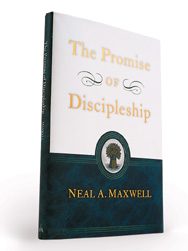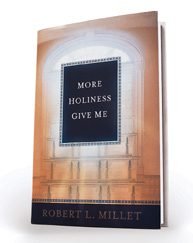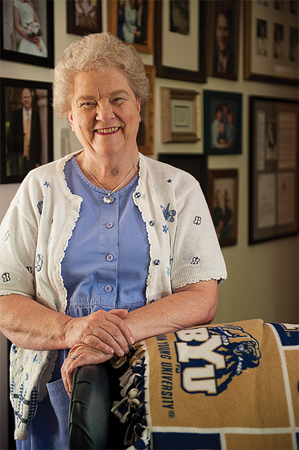By Richard H. Cracroft
 In The Promise of Discipleship (Salt Lake City: Deseret Book, 2001; 145 pp.; $16.95), Elder Neal A. Maxwell of the Quorum of the Twelve of the Church of Jesus Christ does again, and better than ever, what he has been doing for a long time: tellingly defining “the continuing challenge and adventure of discipleship” (p. 1). In this packed and illuminating volume, Elder Maxwell writes with the authority of a seasoned disciple in his “sunset years” of the “commotion” of worldly dissonance; of living in timeless faith while coping in time; of the Lord’s long-suffering; of the justness of His justice; of the nature of the spirit world; and, finally, of the Prophet Joseph Smith. For us plodding disciples of Christ, reading Elder Maxwell (the Latter-day Saints’ inspired upgrade on C.S. Lewis) is like looking into a celestial primer, a motivational refreshing of the eternal perspective, and is the sweetest of incentives to “press on, press on, ye Saints of God.”
In The Promise of Discipleship (Salt Lake City: Deseret Book, 2001; 145 pp.; $16.95), Elder Neal A. Maxwell of the Quorum of the Twelve of the Church of Jesus Christ does again, and better than ever, what he has been doing for a long time: tellingly defining “the continuing challenge and adventure of discipleship” (p. 1). In this packed and illuminating volume, Elder Maxwell writes with the authority of a seasoned disciple in his “sunset years” of the “commotion” of worldly dissonance; of living in timeless faith while coping in time; of the Lord’s long-suffering; of the justness of His justice; of the nature of the spirit world; and, finally, of the Prophet Joseph Smith. For us plodding disciples of Christ, reading Elder Maxwell (the Latter-day Saints’ inspired upgrade on C.S. Lewis) is like looking into a celestial primer, a motivational refreshing of the eternal perspective, and is the sweetest of incentives to “press on, press on, ye Saints of God.”
Elder Jeffrey R. Holland, ’65, also teaches eternal principles in Of Souls, Symbols, and Sacraments (Salt Lake City: Deseret Book, 2001; 37 pp.; $12.95), “a gospel-based view of personal purity” which convincingly explains “why we should be clean [and] why moral discipline is such a significant matter in God’s eyes” (p. 2; emphasis in original). This highly motivational address, first given atBYU in 1988, should be atop the short list of “must reads” for every young man and woman, LDS or not. In A Quiet Heart (Salt Lake City: Bookcraft, 2000; 136 pp.; $15.95), named the best book inLDS devotional literature for 2000 by the Association for Mormon Letters, Patricia Terry Holland describes her personal spiritual quest as a mother, grandmother, and former counselor in the Young Women general presidency: “I am now nearly sixty years old and can honestly say that I have sincerely studied, pondered, experimented, practiced, tried, failed, and started all over again to be meek, to have a peaceful spirit, to have a quiet heart” (p. 105). “You don’t have to worry over so many things,” she seemed to hear Heavenly Father whisper to her one day as she sat overlooking the Sea of Galilee. “The only thing that is . . . truly needful is to keep your eyes toward the sun—my Son. . . . Learn of me, and listen to my words; walk in the meekness of my Spirit, and you shall have peace in me” (p. 37). This book speaks tenderly to LDS women—as my wife, Janice, ’88, attests.
Robert L. Millet, ’73, points out in his very readable More Holiness Give Me (Salt Lake City: Deseret Book, 2001; 246 pp.; $17.95) that “each of us, at one time or another, wrestles with what life is all about and what it takes to be content.” “It is sobering,” he continues, “that someone can possess the fullness of the gospel . . . and still feel empty and unsatisfied” (p. 3). Millet, professor of ancient scripture and former dean of religious education at BYU, examines the ongoing conversion process in climbing the “mountain of spirituality” (p. 6).
In A Treasury of Latter-day Saint Letters (Salt Lake City: Eagle Gate, 2001; 247 pp.; $19.95), Larry E. Morris, ’76, has collected 47 personal letters of Church members. These letters, more than half of which have never been published, proffer fascinating glimpses into the lives and thoughts of prominent Latter-day Saints.
Coke Newell, in Latter Days: An Insider’s Guide to Mormonism, The Church of Jesus Christ of Latter-day Saints (New York: St. Martin’s Griffin, 2001; 270 pp.; $14.95), explains Mormonism to the outside from the inside. In a breezy style Newell tells the Mormon story afresh, beginning with the plan of salvation and ending with the story of his own conversion. It is a good introduction to Mormonism for our nonmember friends and a refreshing refresher course for the Saints.
A fascinating look at Mormonism is 4 Zinas: A Story of Mothers and Daughters on the Mormon Frontier (Salt Lake City: Signature Books, 2000; 497 pp.; $34.95) by Martha Sonntag Bradley and Mary Brown Firmage Woodward, ’37. Here are the stories of Zina Baker Huntington, an early convert; her daughter, Zina Huntington Young, who married Joseph Smith Jr. and Brigham Young, successively, and served as the Relief Society general president; her daughter, Zina Young Card, who assisted her husband, Charles Ora Card, in founding Cardston, Alberta, Can.; and her daughter, Zina Card Brown (Woodward’s mother), who married Hugh B. Brown, a future Counselor in the First Presidency. Bradley and Woodward’s careful research into these lives yields a spiritual and warmly human account of four remarkable women and their contributions to their times, families, communities, and church. In Evolution and Mormonism: A Quest for Understanding (Salt Lake City: Signature Books, 2001; 238 pp.; $19.95), Trent D. Stephens, ’73, D. Jeffrey Meldrum, ’84, with Forrest B. Peterson, approach the sensitive subject of evolu
In Evolution and Mormonism: A Quest for Understanding (Salt Lake City: Signature Books, 2001; 238 pp.; $19.95), Trent D. Stephens, ’73, D. Jeffrey Meldrum, ’84, with Forrest B. Peterson, approach the sensitive subject of evolu
tion from the standpoint of faith. The authors, all committed Latter-day Saints, building upon the fundamental truths that God created the earth and that human beings are His spirit children, examine the traditional concerns of believers and the history of LDS views about evolution; then, examining Holy Scripture, they suggest that the processes of creation attest the hand and bespeak the patterns of God. This is a very helpful, timely, and faithful study.
C. Terry Warner, ’63, professor of philosophy at BYU, presents in Bonds That Make Us Free: Healing Our Relationships, Coming to Ourselves (Salt Lake City: Shadow Mountain, 2001; 346 pp.; $19.95) a lucid study of human relationships. In this celestial primer Warner explains why we so often fall into self-betrayal, violating our own sense of right or wrong. He shows how, by becoming aware of being false, we can break the cycle and restore sweetness to our relationships and thus become liberated from the bonds of negativity and freed to live the gospel of love.
Judy Seegmiller, in Life with Big Al (Early Alzheimer’s): A Caregiver’s Diary (Provo: Big Al, 2000; 154 pp.; $12.95), tells the sad story of her husband, Craig Seegmiller, stricken by early Alzheimer’s (which he termed “Big Al”) at 52, which resulted in his death at 55. I recommend this candid and poignant diary chronicling Craig’s descent into the dark to all who must deal with this illness in a family member or friend. This book is an understated tribute to all Alzheimer’s caregivers, who are, at last, also victims of this heart-breaking disease.
A quick mention of two recent novels and a book of essays: Robert Farrell Smith, in Captain Matrimony (Salt Lake City: Bookcraft, 2001; 264 pp.; $12.95), plunges Andy Phillips, another of his comic heroes, into the throes of a wild and wacky mystery in Mishap, Utah. And a hearty cheer for Robert L. Kirby, noted Mormon humorist and Salt Lake Tribune columnist, for his serio-comic novel, Dark Angel (Springville, Utah: Slickrock Books, 1999; 276 pp.; $12.95). Set in 1869 Utah Territory, Dark Angel is narrated, Huck-Finn like, by 11-year-old tomboy Rose Lee Merrell, nicknamed “Budge.” She and her beautiful 19-year-old half-sister, Laurel Anne, are saved from the molestation of a trio of soldiers by a notorious outlaw who then comes to stay, to teach, and to change their lives. Finally, ma belle Elouise M. Bell, ’59, presents three-dozen brief, pithy, incisive, and delightful personal essays in Madame Ridiculous & Lady Sublime (Salt Lake City: Signature, 2001; 153 pp.; $14.95). With her trademark wit and verve, seasoned with a dash of tartness and a cup of irony, this not-very-retired BYU professor of English (now teaching part-time at Coastal Carolina University) stirs in us a variety of emotions as she comments hindsightfully on the ridiculous and the sublime in the modern world.
Richard H. Cracroft, an emeritus professor of English, lives in Orem, Utah.
Past Book Nook columns can be read online at magazine.byu.edu.









